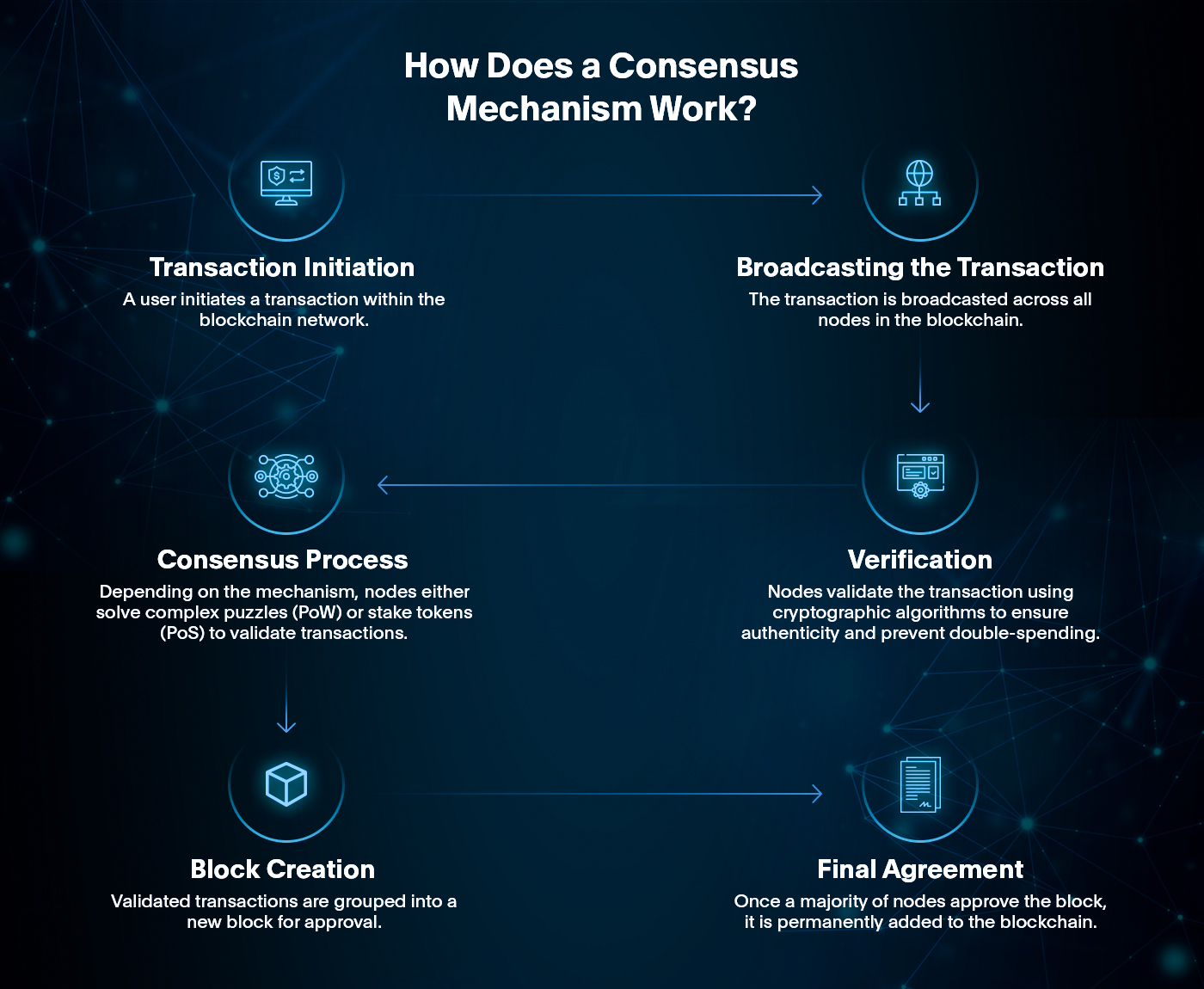Blockchain technology has transformed industries by offering decentralization, security, and transparency. However, the foundation that enables blockchain networks to function seamlessly is the consensus mechanism in blockchain. This mechanism ensures that all participants in a distributed network agree on a single version of the truth, eliminating reliance on intermediaries.
In this blog, we will explore what a consensus mechanism is, how it operates, its significance in blockchain, and how it differs from traditional consensus models. Additionally, we will briefly introduce various types of consensus mechanisms, setting the stage for a more detailed discussion in a separate blog.
What Is a Consensus Mechanism?
A consensus mechanism is a protocol used in blockchain development companies to validate and agree on transactions across a distributed network. It ensures that all nodes (computers) in a blockchain system reach a common agreement on the state of the ledger without needing a central authority.
In conventional financial systems, intermediaries such as banks verify transactions. However, blockchain eliminates these centralized entities and relies on consensus mechanisms to validate transactions. This enhances security, transparency, and trust in the system without requiring a middleman.
How Does a Consensus Mechanism Work?
A consensus mechanism in blockchain enables a decentralized network to maintain integrity and prevent fraudulent activities. Here’s how it functions:

- Transaction Initiation – A user initiates a transaction, such as transferring cryptocurrency or executing a smart contract.
- Broadcasting the Transaction – The transaction is propagated across all nodes in the blockchain network.
- Verification – Nodes validate the transaction using cryptographic algorithms to ensure it is legitimate and prevent issues like double-spending.
- Consensus Process – Depending on the consensus mechanism (Proof of Work, Proof of Stake, etc.), nodes collaborate or compete to approve the transaction.
- Block Creation – Validated transactions are grouped into a new block.
- Final Agreement – Once a majority of nodes approve the block, it is permanently added to the blockchain, and the process continues.
Why Are Consensus Mechanisms Important in Blockchain?
Consensus mechanisms play a crucial role in enterprise blockchain development services by ensuring:
- Trust in a Trustless System – Transactions are validated transparently without a central authority.
- Prevention of Double-Spending – Ensures the same asset is not spent multiple times.
- Enhanced Security – The decentralized nature and cryptographic validation prevent fraud and cyberattacks.
- Decentralization – Unlike traditional financial systems, blockchain relies on distributed validation, reducing central control.
- Scalability and Efficiency – Some consensus models, such as Proof of Stake, optimize transaction speeds and energy consumption.
Types of Consensus Mechanisms
While we will cover these mechanisms in-depth in another blog, here is a brief overview of some widely used consensus mechanisms:
- Proof of Work (PoW) – Used by Bitcoin, it requires solving complex mathematical problems to validate transactions.
- Proof of Stake (PoS) – Validators stake cryptocurrency to confirm transactions, offering an energy-efficient alternative to PoW.
- Delegated Proof of Stake (DPoS) – A variation of PoS where elected representatives validate transactions on behalf of network participants.
- Proof of Authority (PoA) – Transactions are verified by a set of pre-approved nodes, increasing efficiency.
- Proof of Burn (PoB) – Participants destroy (burn) coins to gain mining rights.
- Proof of Elapsed Time (PoET) – Assigns random wait times to determine which node gets to validate the next block.
- Hybrid Consensus Models – Some blockchains combine multiple mechanisms to enhance performance and security.
What Is a Consensus Algorithm in Blockchain?
A consensus algorithm is the technical implementation of a consensus mechanism that determines how transactions are validated and agreed upon. It defines the cryptographic and mathematical rules that ensure fairness, security, and transparency in a blockchain network.
For example:
- PoW Algorithm – Uses computational power to solve complex puzzles and confirm transactions.
- PoS Algorithm – Selects validators based on the number of tokens they stake.
- DPoS Algorithm – Relies on a voting system where stakeholders elect delegates to validate transactions.
These algorithms ensure blockchain networks remain secure, resistant to attacks, and decentralized.
Comparison: Traditional vs. Blockchain Consensus Mechanisms
While consensus mechanisms have existed in various fields, blockchain consensus models differ significantly from traditional ones. Here’s a comparison:
| Feature | Traditional Consensus (e.g., Banking) | Blockchain Consensus (e.g., PoW, PoS) |
| Authority | Centralized (Banks, Governments) | Decentralized (Network Participants) |
| Trust Model | Requires Intermediaries | Trustless (Cryptographic Proofs) |
| Transaction Speed | Faster in some cases | Varies (PoW slower, PoS faster) |
| Security | Vulnerable to fraud/hacks | More secure (Distributed Ledger) |
| Transparency | Limited access to data | Fully transparent and immutable |
| Cost Efficiency | High due to intermediaries | Lower fees in some mechanisms |
Blockchain consensus mechanisms provide a decentralized, secure, and transparent way to validate transactions, offering a robust alternative to traditional centralized models.
Conclusion
Consensus mechanisms form the backbone of custom blockchain development services, ensuring decentralization, security, and efficiency in blockchain networks. Whether through PoW, PoS, or hybrid models, these mechanisms enable transactions without intermediaries, creating trust in digital ecosystems.
As blockchain adoption grows in the United States and India, businesses must understand how different consensus mechanisms work to fully harness the potential of blockchain technology. Stay tuned for our upcoming blog, where we will explore Types of Consensus Mechanisms in greater detail, helping you choose the right one for your enterprise needs. For expert guidance on enterprise blockchain development services, connect with a leading blockchain development company today!